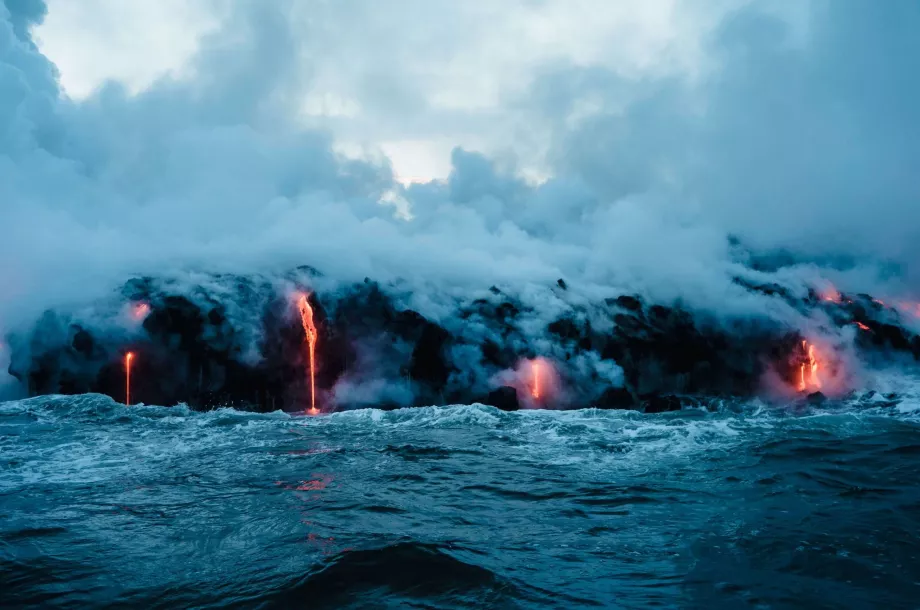Weather in Big Island and best time to go

Thanks to its location on the border of tropical and subtropical zones, the Hawaiian Islands are one of the places that enjoy stable weather all year round without extreme fluctuations and the influence of seasonal rains or winds. Temperatures vary only minimally throughout the year, oscillating between 23 and 30 °C.
However, due to the high mountains and extremely diverse landscape, the weather varies quite significantly within the Big Island itself.
Specifics of Hawai'i's weather
While on the west side around Kailua-Kona you can enjoy year-round temperatures of around 28 °C and almost constant sunshine, on the east side around Hilo it rains very often and the temperature stays at a pleasant 24 °C.
However, the term 'very frequent rain' does not mean a week-long period of unceasing rainfall. It usually rains heavily in the morning or evening, but the rain rarely lasts more than an hour and is usually very limited. If it rains somewhere, you can drive for 10 minutes in any direction and find yourself under blue skies.
Book a hotel with an off-season discount
The weather in the north of the island is warmer and less rainy than in the south.
Take care when travelling to higher altitudes, which you're sure to experience a few times on the Big Island.
Above 1,000m, of course, the weather is more variable and, for example, during the months of December to January, large amounts of snow can fall on top of the 4,000m Mauna Kea and Mauna Loa mountains! Be sure to pack jackets and warmer clothing, even when travelling to Volcanoes National Park, which is largely above 1,000m.
Big Island weather throughout the year
Fancy a cheap ticket to the Big Island, but not sure if the weather is suitable for the time of year? Check out the detailed breakdown by month of the year.
Weather in January
Average temperatures in January on the Big Island are around 27°C on the west coast and 25°C in the east.
January is one of the rainiest months on the west coast, which means one or 2 short showers about once every 4 days. On the east coast, on the other hand, January is one of the average rainfall months - it can rain at any time, it just may not be as heavy as other months.
At altitudes of up to 3,000 metres it regularly snows and you should be prepared for the possibility that the road to the summit of Mauna Kea will be closed. The sea is only suitable for swimming on the west side of the island.
Weather in February
The weather in February is virtually the same as in January. Temperatures range from 25 to 27°C depending on the side of the island, with regular freezing rain and snow on the highest mountains. Temperatures around zero can be exceptional even in the highest parts of Volcanoes National Park.
While the west coast gets very sporadic showers here and there, the east coast gets rain every day. Incidentally, as at any other time of the year, there is no need to worry about prolonged rain, it is always just short showers of an hour or less.
Weather in March
In March, the Hawaiian winter slowly begins to come to an end, which means even more precipitation on the western half of the island. The eastern half of the Big Island is not affected by this decline, with short, heavy and frequent rains. Temperatures throughout the island range from 25 to 27 °C.
The sea is still swimmable only on the west coast, as it is very rough and with dangerous currents in the east.
Weather in April
April is a month that does not deviate from the Hawaiian average. Temperatures oscillate between 26 and 29°C, with the west coast always warmer, where it rarely rains. The east coast, on the other hand, gets regular showers at least once a day.
The best place to bathe is on the west coast, where the sea is calm, while the east coast has big waves and strong currents.
Weather in May
May is one of the mildest months on the Big Island. The air warms up to a Hawaiian classic 26-29°C, and the last remnants of snow melt on Mauna Kea and Mauna Loa.
May is an average rainfall month in the western half of the island, with brief showers about once every 4 days. In the east, May is statistically the month with the least rain, but this means only minor showers.
Weather in June
June temperatures on the Big Island soar to 28°C on the eastern side and up to 30°C in the west. Swimming in the sea is also possible with caution on the east coast.
Rainfall is scarce across the island, but while rain will be a rare occurrence in the west, you'll see it at least once a day - usually in the evening or morning - on the eastern half.
Weather in July
The first month of the holidays is marked by tropical temperatures of around 28 to 30 °C and very sunny weather.
Rain is quite rare on the west coast and does not interfere with active holidays in the east. It rains daily, but always only briefly, with clear geographical boundaries, i.e. it never rains over large areas at once.
The sea is calmest and clearest in July, which means ideal conditions for snorkelling.
Weather in August
August is the peak time of the Hawaiian summer and temperatures are the highest of the year. They regularly rise to 29 to 32°C, but the highest extremes rarely exceed 34°C.
The air is stagnant, muggy and humid, sometimes to the point of being very uncomfortable. This makes August an ideal month for swimming or hiking at higher altitudes, where it will always be more pleasant.
On the west coast, it almost never rains, while on the east coast it rains every day in the form of evening and morning showers.
Weather in September
Even in September you won't experience anything other than summer weather. Temperatures normally rise to between 28 and 30 °C with rare extremes of around 33 °C. Rainfall is similar to August, i.e. nothing in the west and daily showers on the east coast.
September is the last month of the year when the sea is relatively calm even on the east coast.
Weather in October
In October, temperatures on the Big Island range between 26 and 29°C depending on the coastline. This month is the peak of the Pacific hurricane season, which brings more intense showers to the east coast, but as is the case throughout the year, these last no more than an hour at a time.
However, there are frequent brief thunderstorms and very localised and rather mild flooding can occur from time to time, which rarely affects tourism.
The chances of a hurricane arriving in full force directly at the Hawaiian Islands are very small. It happens about once every 20 years, and a tropical storm comes to Hawaii on average once every 2 years, but usually only affects part of the archipelago.
Weather in November
November on the Big Island begins the wet season. However, not much changes for the tourist.
You hardly see any precipitation on the west coast and the eastern half still gets an average of 2-3 times a day for about 30 minutes, it's just a bit more intense than the rest of the year. Expect temperatures between 25 and 29 °C
Swimming in the sea on the west side of the island is totally easy.
Weather in December
December is the coldest month on the Big Island. What does this mean?
Pleasant summer temperatures of between 25 and 28 °C ideal for swimming in the sea on the west side and hiking on the east side of the island. It rains heavily, but usually only for an hour at most, usually in the evening or early morning.
In December, snow often falls on top of Mauna Kea and Mauna Loa and can be inaccessible all day.
Sea temperature on the Big Island
The sea water on the Big Island is at a comfortable temperature suitable for swimming year-round.
The ocean is at its coldest in March, when the water temperature is around 23°C, while it is at its warmest in September and October, when it rises to an average of 27°C.
Table of temperatures during the year
West Coast (Kona) - For beach tourism
East Coast (Hilo) - For volcanic and hiking
When to go to Big Island
Anytime. In the case of the Big Island and the Hawaiian Islands in general, it's really simple. The high season here lasts 365 days a year, and temperatures will be very similar in July and January.
Although Hawaii's seasons are divided into a dry season and a rainy season, they actually differ very little from each other. During the rainy season, individual rainfall events are more intense, but almost never last more than an hour a day.
If you plan to mainly swim in the sea and snorkel, the best conditions are from April to September; if you plan to mainly walk and visit tourist attractions, then the best period is all year round.
If you're planning high altitude hiking above 2,500 metres, it's safer to steer your travels between April and November, but there's little chance of big snowfalls on the peaks of the two highest mountains, even in winter.
The Big Island, unlike the other Hawaiian islands, is not overcrowded even in the peak seasons and can be a pleasant retreat from the busy beaches of Oahu or Maui.
Any questions left?
If you have any questions or comments about the article...

